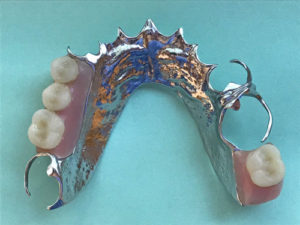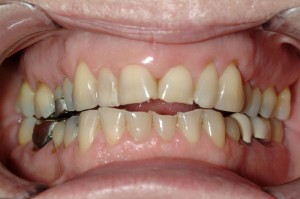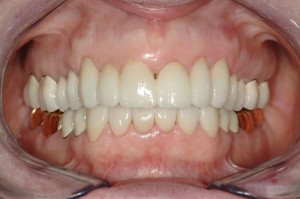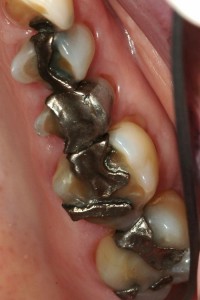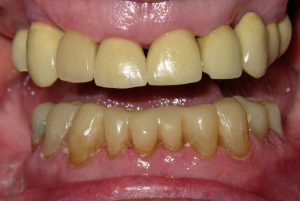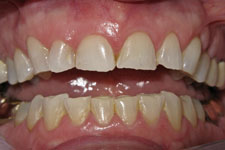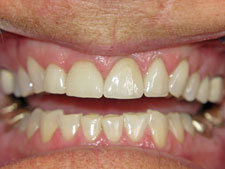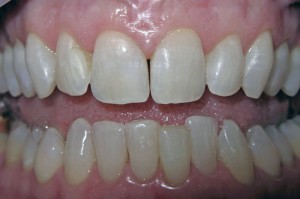Dental Fillings
Composite and Amalgam Fillings
Why do patients need dental fillings and what are they? Dentists use fillings to fix cavities, which are holes in the surface of a tooth. Cavities occur when bacteria interact with sugars in your mouth and produce acid. When acid wears away at the enamel, or hard covering of the tooth, it causes decay. If not removed, decay continues to spread and sometimes reaches a tooth’s nerve, causing it to die. This can cause pain for a patient and sometimes leads to an abscess around the tooth. If an abscess forms, a root canal may be necessary to save the tooth. Our goal is to stop decay before it causes serious problems with a tooth.
Dr. Albers places two types of dental fillings: amalgam (silver colored) and composite (tooth colored). While most patients prefer composite fillings for cosmetic reasons, sometimes Dr. Albers recommends amalgam fillings. When placing fillings, Dr. Albers almost always uses a rubber dam. (See Dr. Albers’ blog post on the benefits of using rubber dams.)
Composite Fillings
Composite dental fillings are made from a tooth colored resin. Many patients prefer composite fillings because they look more natural. It takes Dr. Albers longer to place a composite filling than an amalgam filling because more steps are involved. With composite fillings, after Dr. Albers removes the decay, he etches the enamel, applies a bonding agent, places the composite material, then sets and hardens it with a curing light.
Amalgam Fillings
A good explanation of an amalgam dental filling comes from Mouth Healthy, a website maintained by the American Dental Association (ADA).
Dental amalgam is made from a combination of metals that include mercury, silver, tin, and copper. Sometimes described as “silver-colored” fillings, dental amalgam has been used by dentists for more than 100 years because it lasts a long time and is less expensive than other cavity-filling materials such as tooth-colored composites or gold fillings.
There has been some controversy in the past about the safety of amalgam fillings because they contain mercury. In addition to the Mayo Clinic noting the safety of amalgam fillings, the Mouth Healthy article lists other organizations which conclude amalgam fillings are safe:
It’s important to know that when combined with the other metals, it forms a safe, stable material. Be assured that credible scientific studies affirm the safety of dental amalgam. Study after study shows amalgam is safe and effective for filling cavities. The American Dental Association, U.S. Centers for Disease Control and Prevention, U. S. Food and Drug Administration and World Health Organization all agree that based on extensive scientific evidence, dental amalgam is a safe and effective cavity-filling material. The Alzheimer’s Association, American Academy of Pediatrics, Autism Society of America and National Multiple Sclerosis Society—all science-based organizations like the ADA—also say that amalgam poses no health risk.
Composite Filling V. Amalgam Filling
Although composite dental fillings are more visually pleasing to many patients, Dr. Albers will sometimes recommend an amalgam filling. Why? Because amalgam fillings are stronger than composite fillings. If he needs to fill a larger cavity in one of the back teeth used for chewing, he will often recommend amalgam fillings as they tend to hold up better over time. Amalgam fillings are also less expensive than composite fillings, so sometimes they are a better financial option for a patient.
What Is The Best Dental Filling?
We’re going to borrow a few lines from the Mouth Healthy article on fillings:
“Ultimately, the best dental filling is no dental filling. Prevention is the best medicine. You can dramatically decrease your risk of cavities and other dental diseases simply by:
- Brushing your teeth twice a day with fluoride toothpaste
- Flossing daily
- Eating a balanced diet
- Visiting the dentist regularly”
Remember, prevention is key!
Dental Crowns
Dental crowns help us restore strength and function to an otherwise weakened tooth. They are an important part of what we do in our office, and come in three basic forms: All ceramic, gold, and ceramic fused to metal.
The following list gives examples of situations where a crown might be recommended for a patient:
- Large restorations (fillings) are present leaving little tooth structure to maintain the strength of a tooth
- We find a crack or fracture in the tooth
- A patient has a severely worn tooth
- An existing tooth needs additional strength to support a bridge
- We want to add strength to a root canal tooth
- A patient wants to cover up severely discolored or misshapen teeth
- Creation of a restoration for a dental implant
- To improve the aesthetics or cosmetic features of a smile
All Ceramic Crowns
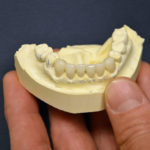
All ceramic crowns
Most of the dental crowns our office places are all ceramic crowns. All ceramic crowns are a good choice for most patients as they provide the support necessary to help protect the tooth, but do so in a cosmetically pleasing way. Most crowns placed on teeth towards the front of a patient’s mouth will be all ceramic crowns.
Gold Crowns
If a patient needs a crown on a tooth in the back of the mouth, Dr. Albers often recommends using a gold crown. While crowns made of gold are not as aesthetically pleasing to patients, they are more durable than all ceramic crowns. This becomes important when the teeth involved are molars, the teeth at the very back of your mouth used for chewing. While Dr. Albers can explain different options and make recommendations, the patient will make the final decision.
Porcelain Fused To Metal Crowns
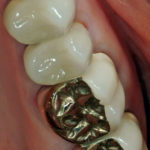
Four PFM crowns
On rare occasions, Dr. Albers might recommend a porcelain fused to metal crown (PFM). This type of crown has a metal substructure with porcelain overlaid on top of the metal. If a patient has decay under the gum line, a PFM crown can be made with a thinner collar of material, making it fit better over the tooth. The porcelain overlay of a PFM maintains a pleasing cosmetic appearance for the patient. This photo shows four PFM crowns – two with porcelain around the sides, and two with porcelain covering the sides and bottom of the metal.
Although porcelain fused to metal crowns have been good options for patients in the past, they are used less frequently now. This stems from the fact that newer ceramic crowns have greater strength and durability than they used to.
Dental crowns play a big role in protecting teeth from further deterioration. They are both restorative – meaning they are helping maintain tooth structure and function – and cosmetic, as they can restore a natural looking smile. See this short informative video about crowns at Mouth Healthy, a website maintained by the American Dental Association (ADA). Bottom line, Dr. Albers and his staff have the experience necessary to help patients determine what type of crown best meets their needs.
Dental Bridges
A dental bridge is a dental appliance used by dentists to replace missing teeth. Similar to a bridge over water, a dental bridge requires a support system on both sides of the span of missing teeth. Typically, a bridge replaces four or fewer teeth. A dental bridge is made of metal and porcelain, similar to a porcelain fused to metal crown, and is cemented into place. They can only be removed by a dentist.
Process For Making A Bridge
Dr. Albers prepares the supporting teeth on each side of the missing teeth for crowns. He then takes impressions and makes a temporary bridge. The impressions are sent to a dental lab for fabrication of the bridge. Finally, Dr. Albers checks the finished dental appliance for fit and then cements it into place.
The drawback to using dental bridges to restore missing teeth is that the supporting teeth need to be crowned in order to anchor the bridge. When three or more teeth are missing, another option is to use dental implants in place of two of the missing teeth, and then fashion a bridge for the remaining missing teeth. While a dental implant bridge might be preferable in terms of retaining existing tooth structure, it is a more expensive option.
Dental Bridges Restore Function and Appearance
Even though there are downsides to using dental bridges, they are important for several reasons. When you lose a tooth or teeth, other teeth in the mouth can migrate or change position over time. This can cause problems with a patient’s bite, or the way their teeth contact when they bite down. If teeth are not contacting correctly, it can impact the way the mouth functions.
In addition to restoring function to the mouth, bridges also improve the appearance of teeth and smiles. We find this often gives patients more confidence in their interactions with others.
Root Canals
Don’t Be Afraid of Root Canals
Root canals may be the dental procedure patients fear the most. But, we hope to explain why root canals are sometimes necessary to protect and save a tooth and why patients should not fear them.
A good starting point for this discussion is an informative article and video about root canals at Mouth Healthy, a website maintained by the American Dental Association (ADA). The article includes a diagram of a tooth and explains how healthy teeth receive nourishment through blood supplied to them through the canals in a tooth.
The Mouth Healthy article contains the following explanation of a root canal:
The pulp is soft tissue inside your tooth that contains nerves, blood vessels and provides nourishment for your tooth. It can become infected if you have:
- A deep cavity
- Repeated dental procedures that disturb this tissue
- A cracked or fractured tooth Injury to the tooth (even if there’s not a visible crack or chip)
If untreated, the tissues around the root of your tooth can become infected. When this happens, you will often feel pain and swelling and an abscess may form inside the tooth and/or in the bone around the end of the root of the tooth. An infection can also put you at risk of losing your tooth completely because bacteria can damage the bone that keeps your tooth connected to your jaw.
When patients come to our office with symptoms of nerve damage or infection, Dr. Albers opens up the tooth to reduce pressure caused by swelling from the infection. He also treats it with an antibiotic. If he determines that the nerve is dying or dead, he then begins the process of cleaning the canals in the tooth of nerve and other soft tissue. After thoroughly cleaning out the root canals, Dr. Albers fills them with a rubberized material to completely seal them.
When a tooth no longer has a nerve and blood supply, it becomes more brittle. For this reason, Dr. Albers sometimes recommends that a dental crown be placed on a tooth after a root canal to protect and strengthen it.
As a general dental office, we make all types of dentures for patients who need them. When making dentures, we focus on comfort, function, and appearance. From full to partial dentures, from cast to acrylic, we can usually provide what our patients need.
Dentures in General
Full dentures are made from acrylic and as the title implies, are used when a patient has lost all of their teeth. Sometimes this involves only the upper teeth, sometimes only the lower teeth. Usually, though, we see patients who need both upper and lower dentures. They are generally removable, but with the advent of implant dentistry, are sometimes fastened onto dental implants.
Conventional and Immediate Dentures

Denture casts
Conventional dentures require multiple appointments to ensure the best comfort and function. In a typical case, a patient comes in for first impressions, from which Dr. Albers makes custom trays. At a second appointment, Dr. Albers uses the custom trays to take final, more accurate impressions. Using the second impressions, Dr. Albers makes stone casts. He then uses wax to place teeth in their proper position. A patient will come in for a trial fit. Once Dr. Albers and the patient are happy with fit, function and appearance, he sends the final try-in to a dental lab for processing, replacing the wax with acrylic. At the final appointment, Dr. Albers ensures that comfort, function, and appearance are all working to his and the patient’s satisfaction.
An immediate denture is one that is placed immediately after any remaining teeth are removed. In such a case, Dr. Albers takes an impression, prepares a stone cast, and prepares a wax model with teeth placement. This is sent to a dental lab for fabrication. The lab sends the denture to the oral surgeon’s office before the patient’s appointment to remove their remaining teeth. The oral surgeon then places the denture. Dr. Albers generally sees the patient the next day to check the fit of the denture and make any needed adjustments.
Because immediately dentures are placed “immediately” after teeth removal, there is no time for healing to occur or swelling to recede. Dr. Albers will sometimes reline a denture or remake them after gums are fully healed. While conventional dentures allow the best fit due to the multiple appointments to fine tune them, many patients opt for immediate dentures rather going without teeth for several months while their gums heal.
Cast And All Acrylic Partial Dentures
Partial dentures are used when some, but not all teeth are missing. They come in two basic forms – cast partials, which incorporate metal, and partials made completely from acrylic.
When we partial denture, we take an impression and send it to a lab for the metal framework to be made. Once made, Dr. Albers will try it in a patient’s mouth to confirm the fit. We then send the partial back to the lab so that acrylic and teeth can be added. Dr. Albers works with the lab to match the color of the teeth in the partial to a patient’s remaining teeth. An appointment is scheduled to deliver the partial and check the patient’s bite.
Partials made from all acrylic are bulkier and not as form fitting as a cast partial denture. As a result, they don’t always feel as comfortable. Also, food tends to get caught underneath acrylic partials more easily. For many patients, though, they make sense because they are less expensive than cast partial dentures. When working with patients, we try to find the option best suited for that patient’s needs and finances.
We work with our patients on good, preventative dental care, but sometimes they lose teeth anyway. Dentures can restore function and appearance for those who have lost teeth. For more information, Mouth Healthy, a website maintained by the American Dental Association (ADA), has an article and short video discussing dentures and how to properly care for them.
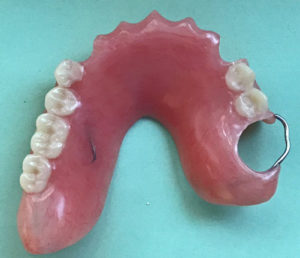
A partial denture made from acrylic


